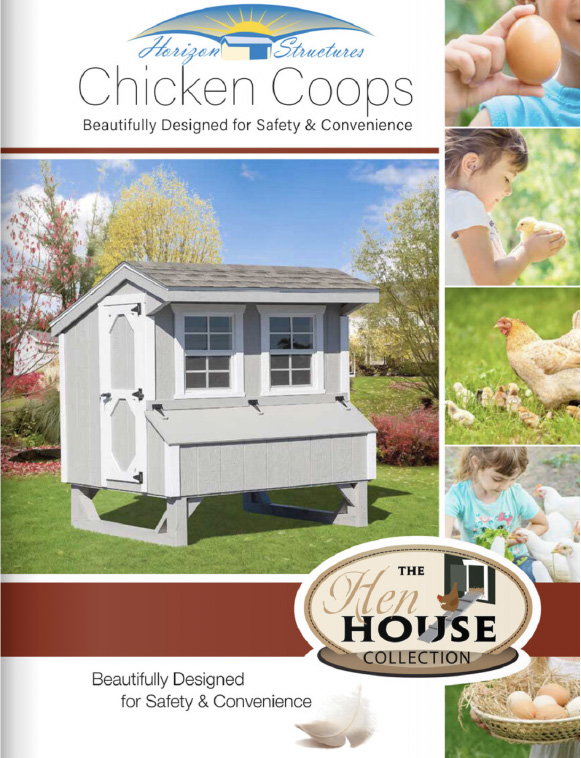Top 10 Tips to Keep “Cluckingham Palace” Residents Happily Housed
By Nikki Alvin-Smith

The chicken keeping care of the Ms. Hennypenny’s in your life does not have to dictate your schedule or send you into a flap with unwanted upsetting discoveries. Issues with broody hens, loss of birds to parasites, predators or bad weather, infighting and fleeing fowl, can mostly be avoided with a smart coop design and a few simple management methods.
The health and hygiene, safety and security of the ladies of the court, is of paramount importance. Happy chickens will be laying chickens, so keeping their lives as stress free and pleasurable as possible is the key to a plentiful egg count.
Here, in no particular order, are the top ten tips on how to keep your ‘Cluckingham Palace’ free of drama and ensure it operates like a well-run royal household.
1. Easy Clean Coop Designs Save Time & Torture
Chickens may not produce the manure mess and mayhem of their larger farm family counterparts like cows, goats or sheep, but the ‘eau de gallus domesticus’ is not a highly appreciated aroma by the majority of mankind.
A clean coop is an important component for the health of chickens and helps to keep parasitic issues in check and the residents free of diseases. Aside from during winter months, where for warmth in cold climates a deep litter bed may be warranted (see tip below on this topic), removing chicken poop from the coop is necessary and should be done on a regular basis.
Keeping the coop clean can be a torturous experience if the roof is low and cleaner of the chicken chambers is forced to bend over double to complete the task. Tools and tackle can help make the job easier, but truly making a clean sweep is much more easily accomplished if the laying boxes and roost bars are not raised off the floor but there is an easy outside access for cleaning. Wire mesh with chicken friendly foot cover set under the boxes is an additional boon, as ‘materials’ can make their way through to the floor below for clean-up.
Seamless smooth floors also make cleaning easier. Some manufacturers
offer a pullout tray with a Glasbord floor that makes hygiene maintenance fast and efficient that is well worth considering if labor saving options are high on your list of priorities.
Fiberglass products like Glasbord offer approximately ten times the cleanability, six times the stain resistance, and twice the abrasion resistance of ordinary chicken coop floor options and meet USDA/FSIS requirements. A non-toxic epoxy resin painted on top of the Glasbord offers even better resistance to stains and damage.
2. Take Advantage of Technological Advances
‘There’s an app for that’ is at this point a time worn phrase many of us are tired of hearing but the rapid integration of technology into our lives offers advantages for the chickenkeeper that not only save time and worry. ‘Smart options’ can also literally save loss of chicken life.
A chicken coop fitted with automatic doors that can be set to open at designated times electronically offers peace of mind and saves much to and fro for the chickenkeeper who has other demands on their time.
Via GPS technology automated doors can even adjust their timing each day to offer the perfect programming of their operation to optimize their benefit lest the chicken caregiving person should ‘forget’ or be away from home and unable to let the chickens out in the morning or tuck them up safely in their bunks at dusk.
“Eyes on the target” can also be managed via smart cams and apps, that monitor the activities of the chickens in real time and provide a level of insight and sometimes entertainment into chicken life and activities of the court of hens after hours.
While the voyeurism may seem the height of paparazzi intrusion or chicken keeping paranoia, knowledge of exactly what is going on behind closed doors after hours or outside the coop during daylight or night hours can provide valuable information including presence of prying predators.
3. Free Range or Free Meal?
Chickens that are allowed the run of the property can be useful for mitigating the numbers of pesky insects and weed seeds. Bear in mind chickens have not read up on the difference between a weed and a flower, so they will feed on flowers and vegetable plants too. If you are an avid gardener without a greenhouse the free-range method of chicken keeping may not be for you.
However, the chicken without a chicken run can find itself ‘on the run’ from aerial and ground predators. While raptors roam the skies and four-footed family pets or earthbound wildlife may pose a danger to the chicken population, vehicles can also pose a hazard to the chicken that crosses the proverbial road or driveway.
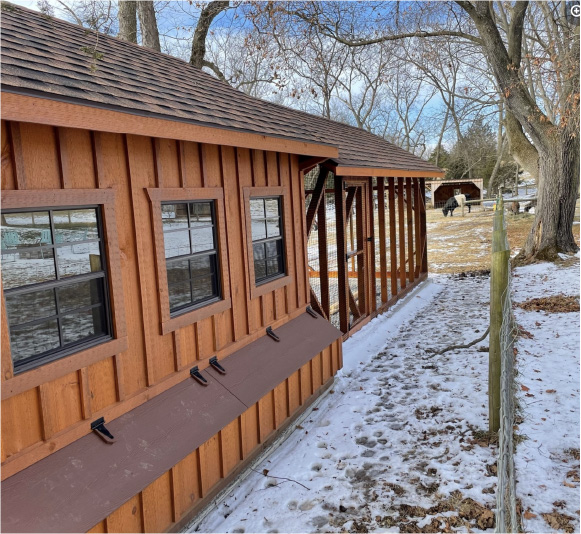
Clipping a chicken’s feathers twice a year is a good remedy to prevent birds flying off and getting into trouble.
A chicken run allows the birds room to peck and hunt and enjoy the company of their colleagues but if it is to be a safe sanctuary certain design features should be implemented.
While predators can dig under fences to secure their chicken dinner, chickens can also dig their way out of forced confinement and can escape under wire mesh fences and ground boards with little effort. To keep chickens in and predators out, run the wire mesh fence or other boundary material at least 1 foot down into the ground on the perimeter of the enclosure.
Alternatively, a compacted stonedust over gravel or concrete floor that extends past the perimeter of the enclosure onto the apron area of the site of the coop can be installed.
The threat from birds of prey from the skies above should also be addressed with some form of netting, wire mesh or wood or metal roof over the chicken run. The advantage of a solid roof over the run is it will also offer shelter for the flock from snow and sun.
Editor’s Note: A brief interview with chicken keeper Danylle Ballard in Windham, NY yielded some additional advice on ways to protect your chickens from birds of prey. After losing one of her chickens to an aerial predator, Danylle bought a female goose to protect her flock:
“I have a Tallahassee goose called Josie who lives with my flock. See constantly scans the sky for hawks and eagles and if she sees anything she will run to the coop and all the chickens follow her. I haven’t lost a chicken since I got her. I also learned the hard way, that white colored chickens such as the Leghorn chickens, are too easily spotted on the grass due to their color by birds of prey. So avoid the white color chickens, even though they laid very pretty eggs - unless you have a run that gives the chickens protection from above."
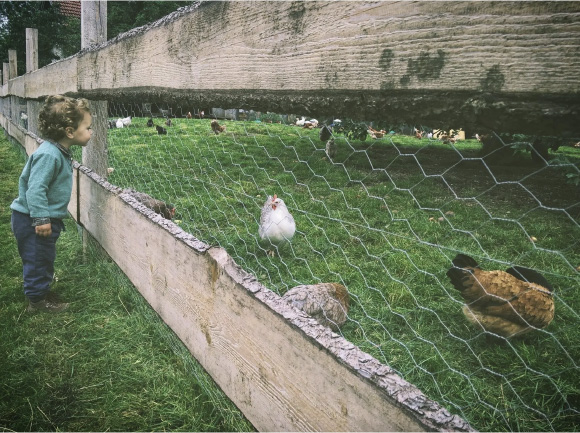
4. Wheels Up?
The chicken tractor or pull-it coop offers several neat benefits especially for smaller flocks of chickens (usually 7-9 chickens a coop) or property owners with limited space.
Moving the coop with the help of a friend or utilizing a lawn tractor or ATV means the natural fertilizing and insect control the chickens offer can be migrated around the backyard to keep the lawn down. Lift kits installed on the coop are also available to aid in the portability of smaller coops.
The ‘wheels up’ option is a popular design but also be aware that as the unit sits on top of the ground there is no protection from digging predators.
5. The Feeding Factor
Hanging feeders are especially useful for moveable coops, while wall feeders may be best for smaller spaces and larger operations will need an extremely durable vermin and weatherproof multi-feeder.
There is a myriad of options for feeders and it is smart to choose wisely to minimize feed being wasted or attracting the wrong animals to join in the feast.
The use of automatic feeders set on a timer system can work well to save effort on the part of the caregiver. However, their operation and supply should be regularly checked as chickens can starve within 4-6 days if left without a food supply.
Ideally a chicken will have access to food 24 hours a day, but a daily feeding is a minimum requirement. Optimal feeding regimes will include approximately 0.25 pounds of nutrient rich poultry feed per chicken per day. A balanced diet is very important too.
Opting out of purchasing expensive grain is possible but feeding ‘scraps’ also requires a diligent effort to ensure chickens are receiving the minerals and vitamins they require as well as provision of proteins and other components that address their dietary needs
Happily housed and well-fed chicken flocks will reward their caregiver by staying healthy and laying eggs. Bald chickens, chickens eating their own eggs, and all manner of health issues can be avoided with a little research on their dietary requirements. The iconic medical source, The Merck Manual offers a veterinary level insight into the topic.
Remember that any change in feed brands or types of feed can disrupt egg laying rhythm. Avoid cheaper feed rations that may contain pesticides or chemicals. A high-quality chicken feed designed for laying hens will help ensure egg production.
Chickens have no teeth and require grit in their diet to enable them to properly digest their food. Crushed oyster shells are a good source of grit for chickens.
6. Water Rations
When it comes to chicken care obviously water should never be rationed. Provision of clean drinking water is essential to the health of the chickens. Keeping the water from freezing in cold winter months can present a challenge. Eating snow is no substitute for a water supply. TV host and 5th generation chickenkeeper Lisa Steele, has a great advice on how to keep your chickens’ water supply from freezing.
It is important to ensure chickens are never left without water. While in mild conditions a chicken may live up to 48 hours without water, in hot weather they can dehydrate and die in as little as 8 hours.
One hour without water can make a chicken stop laying for a week!
7. Avoiding Winter Woes ~ Lamps, Solar Solutions and more
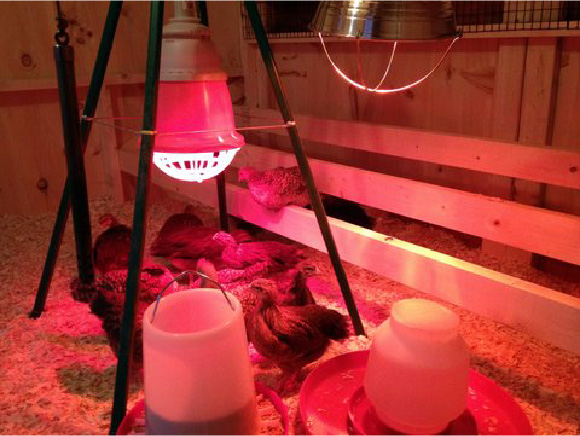 The use of heat lamps in coops is commonplace and providing a few simple safety precautions are heeded the heat lamp can be a literal lifesaver when it comes to housing chickens in colder climes.
The use of heat lamps in coops is commonplace and providing a few simple safety precautions are heeded the heat lamp can be a literal lifesaver when it comes to housing chickens in colder climes.
The modern approach of providing an equitable temperature in chicken housing with the use of radiant heat, solar panels and air-conditioning is a far cry from the chicken coop and chicken keeping methods such as deep litter bedding and the designs of homemade coops in the days of yore. The ladies of the chicken royal court do not need to be housed in a chilly castle.
Coop design plays an important part in keeping chickens healthy in winter. Details such as the roosting bars/perches being wide enough and edged flat so that chickens can keep their vulnerable feet covered and the coop being ventilated but free from drafts are two good examples of how to keep your hens happy.
The cozier or smaller the coop the warmer it will likely stay. An insulated chicken coop will be warmer in winter and cooler in summer. There are many techniques for increasing heat within the coop such as adding curtains to nest boxes, partitioning the coop into sections with solid dividers for winter months etc.
Extra feed rations and certain types of food can help chickens stay warmer during extreme temperatures.
Moving the coop to a warmer location for winter versus summer living is another option.
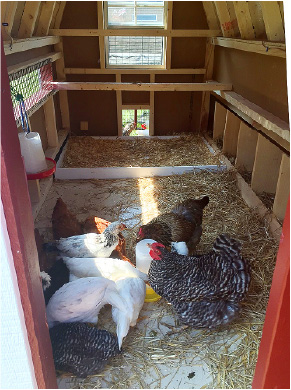 Electric service to the coop may be ideal, though is not always practical or wanted. Use of batteries to provide power for remote locations that can service both light and heat fixtures with a solar feed is one way to solve the issue of no direct electrical service to the coop.
Electric service to the coop may be ideal, though is not always practical or wanted. Use of batteries to provide power for remote locations that can service both light and heat fixtures with a solar feed is one way to solve the issue of no direct electrical service to the coop.
8. Chickens Behaving Badly
The most common reason that chickens begin to bully each other or behave badly is lack of space. Chickens vary in size by breed, and coops need to be designed to provide enough space at ‘Cluckingham Palace’ for the flock to co-exist in harmony.
The general rule is to allow 3 square feet of space per chicken inside the coop and 15 square feet of roaming space per chicken outside the coop.
9. Egg Conundrums
When chickens are laying everyone is happy. But sometimes the eggs are not in the best ‘shape.’
Eggs with cracked shells or ‘missing eggs’, usually because they have been eaten by the chickens themselves, are issues that can usually be addressed by prompt and regular egg collection on a schedule 2 times per day.
As chickens usually lay their eggs in the morning (due to circadian rhythm if artificial light source is not provided) the best time to collect eggs is at noon if a once daily collection is all that can be managed. Chickens rarely lay after 2 p.m.
Thin or thick shelled eggs and general egg quality can be affected by a myriad of issues.
Hens won’t lay eggs at all during their annual molting period. This is normal and usually last 10-12 weeks.
Remember you do not need to have a rooster for hens to provide eggs.
10. Know The Law
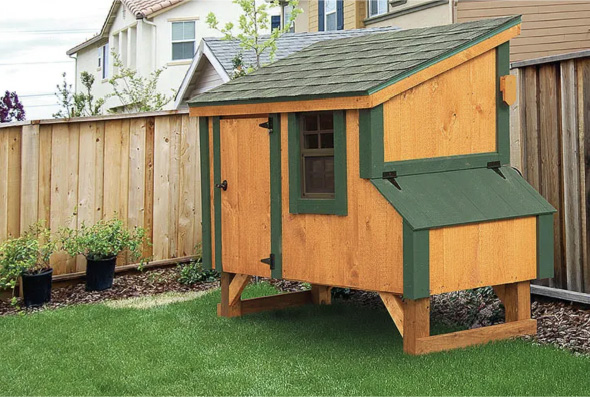
The laws on keeping chickens vary widely from city to town and from State to State. Many urban areas do allow chicken keeping even within city limits, but it is prudent to check with your own town ordinances before embarking on your chickenkeeping enterprise.
Inspired to keep chickens or upgrade your current ‘Cluckingham Palace’?
Enjoy viewing this just released comprehensive “The Hen House Collection” catalog from Horizon Structures LLC, one of the leading producers of Amish crafted chicken coops.



